Curiosity Mars rover completes key pre-launch tests
By WILLIAM HARWOOD
CBS News
KENNEDY SPACE CENTER, FL--NASA's $2.4 billion Mars Science Laboratory has completed an exhaustive series of functional tests to verify the car-size rover's readiness for launch in November on an eight-and-a-half-month voyage to the red planet and a dramatic rocket-powered "sky crane" descent to the surface, officials said Friday.
Engineers now plan to carefully fold up the rover's robot arm, its camera mast, wheels and suspension so it can be packed inside a protective aeroshell that, in turn, will be attached to the bottom of a rocket-powered descent stage. The entire spacecraft then will be attached to its interplanetary cruise stage, encapsulated in a nose cone fairing in late October and hauled out to launch complex 41 at the Cape Canaveral Air Force Station for attachment to a United Launch Alliance Atlas 5 rocket.
Liftoff is targeted for 10:21 a.m. EST (GMT-5) on November 25.
"We just wrapped up our last functional test of the vehicle," said Dave Gruel, MSL assembly, test and launch operations -- ATLO -- manager for the Jet Propulsion Laboratory. "Our functional test campaign included things like showing the vehicle can successfully go and do our entry, descent and landing phase, get down to the surface and actually deploy the arm, deploy the mast, take images, things of that nature."
Starting Saturday, he said, "we're going to start stowing the vehicle for launch. We're going to take the arm and we're going to put the arm up tight, nice and close up against the vehicle, we're going to put the mast down, we're going to tuck the mobility system up nice and tight and that's the configuration the rover's in at launch."
"At that point, we take the descent stage, that's the sky crane, and the descent stage just lowers on top of the rover," Gruel said. "That whole thing makes its way inside the aeroshell, that's a protective vehicle we use to go through the atmosphere to protect us from the heat that's generated. The last thing we do is put that whole device up into the cruise stage."
MSL's nuclear power pack, a radioisotope thermoelectric generator, will be installed late in the processing flow.
"It's pretty overwhelming," Gruel said. "We all got to see the Juno launch just a couple days ago and realizing we are next up, that the next rocket that's going to be on the pad is going to be for MSL, is a pretty humbling experience for the team. So we all realized that the finish line's upon us with respect to getting Curiosity ready to launch. We're all really confident we've exercised (the rover) to the best of our ability and what's next up for Curiosity is getting down to the surface of Mars and showing us what she's capable of doing."
NASA gave journalists a final chance to view the MSL flight hardware Friday before the rover is packed up for launch.
The Mars Science Laboratory rover, dubbed Curiosity in a student-naming contest, is the most sophisticated unmanned spacecraft ever built to rove about the surface of another planet.
Unlike past Mars missions, the Curiosity rover will not set down atop a legged lander or bounce to the surface encased in shock-absorbing airbags. Instead, it will be lowered to the ground and set on its wheels by a slowly descending "sky crane" designed to unreel the lander like a lure on a fishing line.
The sky crane is equipped with an inertial measurement unit and a radar altimeter that will feed velocity and altitude data to a sophisticated flight computer inside the rover. The computer, in turn, will command canted hydrazine rocket thrusters on each corner of the sky crane to put the craft in a controlled vertical descent at a sedate 1.7 mph.
Finally, at an altitude of around 65 feet, a gravity-fed harness system will lower the MSL rover away from the sky crane, which will continue its descent until the rover's wheels touch down. Sensing the change in its load, the computer will send commands to release the harness and cables and the sky crane, its job complete, will fly off to a crash landing a safe distance away.
The rover, meanwhile, will be ready to begin two Earth years of exploration to look for carbon compounds and evidence of past or present habitability. The rover also will study the chemistry and composition of rocks and soil in the landing zone, assess weather patterns, measure the radiation environment, and determine the long-term distribution of water and carbon dioxide.
-----------------------
Earlier stories:
August 2010 Mission Preview
August 2010 Entry, Descent and Landing
August 2010 MSL Science
CBS News
KENNEDY SPACE CENTER, FL--NASA's $2.4 billion Mars Science Laboratory has completed an exhaustive series of functional tests to verify the car-size rover's readiness for launch in November on an eight-and-a-half-month voyage to the red planet and a dramatic rocket-powered "sky crane" descent to the surface, officials said Friday.
Engineers now plan to carefully fold up the rover's robot arm, its camera mast, wheels and suspension so it can be packed inside a protective aeroshell that, in turn, will be attached to the bottom of a rocket-powered descent stage. The entire spacecraft then will be attached to its interplanetary cruise stage, encapsulated in a nose cone fairing in late October and hauled out to launch complex 41 at the Cape Canaveral Air Force Station for attachment to a United Launch Alliance Atlas 5 rocket.
Liftoff is targeted for 10:21 a.m. EST (GMT-5) on November 25.
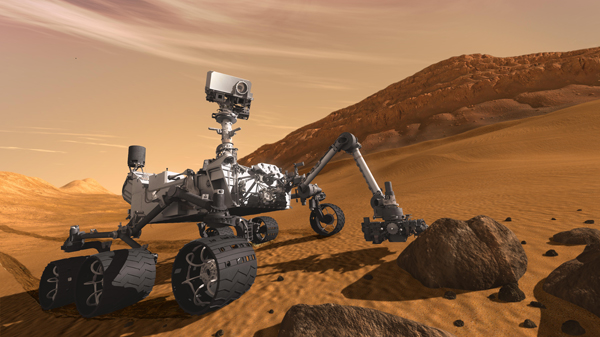 |
| A computer graphic showing the Curiosity rover on Mars. (NASA) |
"We just wrapped up our last functional test of the vehicle," said Dave Gruel, MSL assembly, test and launch operations -- ATLO -- manager for the Jet Propulsion Laboratory. "Our functional test campaign included things like showing the vehicle can successfully go and do our entry, descent and landing phase, get down to the surface and actually deploy the arm, deploy the mast, take images, things of that nature."
Starting Saturday, he said, "we're going to start stowing the vehicle for launch. We're going to take the arm and we're going to put the arm up tight, nice and close up against the vehicle, we're going to put the mast down, we're going to tuck the mobility system up nice and tight and that's the configuration the rover's in at launch."
"At that point, we take the descent stage, that's the sky crane, and the descent stage just lowers on top of the rover," Gruel said. "That whole thing makes its way inside the aeroshell, that's a protective vehicle we use to go through the atmosphere to protect us from the heat that's generated. The last thing we do is put that whole device up into the cruise stage."
MSL's nuclear power pack, a radioisotope thermoelectric generator, will be installed late in the processing flow.
"It's pretty overwhelming," Gruel said. "We all got to see the Juno launch just a couple days ago and realizing we are next up, that the next rocket that's going to be on the pad is going to be for MSL, is a pretty humbling experience for the team. So we all realized that the finish line's upon us with respect to getting Curiosity ready to launch. We're all really confident we've exercised (the rover) to the best of our ability and what's next up for Curiosity is getting down to the surface of Mars and showing us what she's capable of doing."
NASA gave journalists a final chance to view the MSL flight hardware Friday before the rover is packed up for launch.
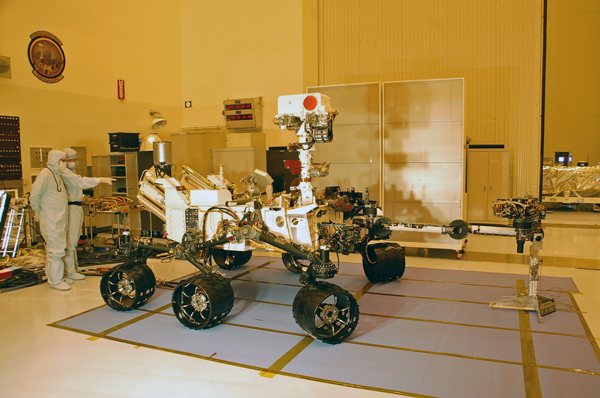 |
| The Mars Science Laboratory rover Curiosity at the Kennedy Space Center during final checkout. (Credit: William Harwood/CBS News) |
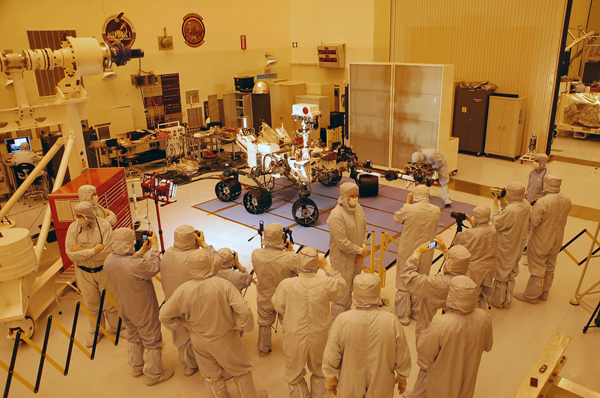 |
| Journalists get a final chance to inspect the Curiosity rover before it is packed up for launch in November. (Credit: William Harwood/CBS News) |
 |
| The rocket-powered "sky crane" descent stage that will lower Curiosity to the surface of Mars. (Credit: William Harwood/CBS News) |
 |
| A brace holding Curiosity's robot arm features a California license plate. (Credit: William Harwood/CBS News) |
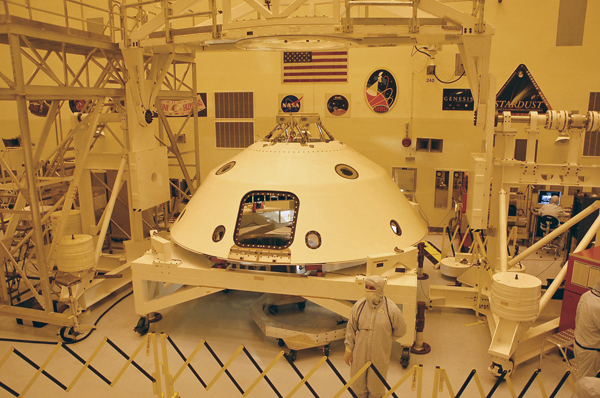 |
| The conical aeroshell will protect the Mars Science Laboratory during its descent into the atmosphere of Mars. (Credit: William Harwood/CBS News) |
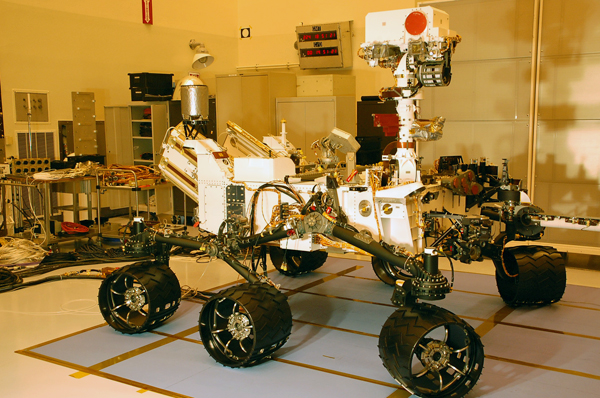 |
| The Mars Science Laboratory. (Credit: William Harwood/CBS News) |
The Mars Science Laboratory rover, dubbed Curiosity in a student-naming contest, is the most sophisticated unmanned spacecraft ever built to rove about the surface of another planet.
Unlike past Mars missions, the Curiosity rover will not set down atop a legged lander or bounce to the surface encased in shock-absorbing airbags. Instead, it will be lowered to the ground and set on its wheels by a slowly descending "sky crane" designed to unreel the lander like a lure on a fishing line.
The sky crane is equipped with an inertial measurement unit and a radar altimeter that will feed velocity and altitude data to a sophisticated flight computer inside the rover. The computer, in turn, will command canted hydrazine rocket thrusters on each corner of the sky crane to put the craft in a controlled vertical descent at a sedate 1.7 mph.
Finally, at an altitude of around 65 feet, a gravity-fed harness system will lower the MSL rover away from the sky crane, which will continue its descent until the rover's wheels touch down. Sensing the change in its load, the computer will send commands to release the harness and cables and the sky crane, its job complete, will fly off to a crash landing a safe distance away.
The rover, meanwhile, will be ready to begin two Earth years of exploration to look for carbon compounds and evidence of past or present habitability. The rover also will study the chemistry and composition of rocks and soil in the landing zone, assess weather patterns, measure the radiation environment, and determine the long-term distribution of water and carbon dioxide.
-----------------------
Earlier stories:
August 2010 Mission Preview
August 2010 Entry, Descent and Landing
August 2010 MSL Science